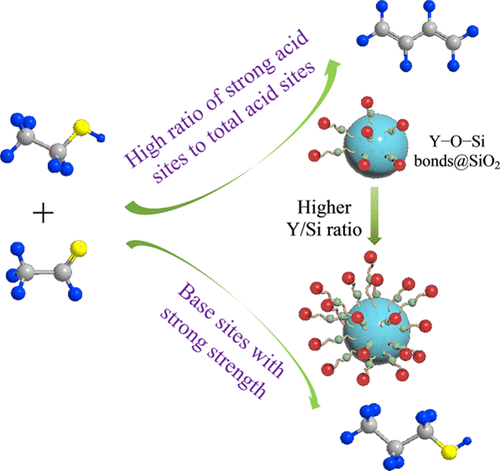当前位置:
X-MOL 学术
›
ACS Sustain. Chem. Eng.
›
论文详情
Our official English website, www.x-mol.net, welcomes your feedback! (Note: you will need to create a separate account there.)
Effect of Catalyst Structure and Acid–Base Property on the Multiproduct Upgrade of Ethanol and Acetaldehyde to C4 (Butadiene and Butanol) over the Y–SiO2 Catalysts
ACS Sustainable Chemistry & Engineering ( IF 8.4 ) Pub Date : 2020-01-14 , DOI: 10.1021/acssuschemeng.9b06199 Qiangqiang Zhu 1 , Lilin Yin 1 , Kaiyue Ji 1 , Chao Li 1 , Bin Wang 1, 2 , Tianwei Tan 1
ACS Sustainable Chemistry & Engineering ( IF 8.4 ) Pub Date : 2020-01-14 , DOI: 10.1021/acssuschemeng.9b06199 Qiangqiang Zhu 1 , Lilin Yin 1 , Kaiyue Ji 1 , Chao Li 1 , Bin Wang 1, 2 , Tianwei Tan 1
Affiliation

|
The multiproduct upgrade of ethanol and acetaldehyde to butadiene as a high-value chemical and butanol as a biofuel was investigated over the Y–SiO2 heterogeneous catalysts. The sum selectivity of butanol and butadiene is over 90% for the Y–SiO2 catalysts with Y/Si ratios from 0.05 to 0.35, while the distribution changes with the Y/Si ratio. The highest butadiene selectivity of 81.2% with a butanol selectivity of 10.3% was obtained over the Y–SiO2 catalyst with a Y/Si ratio of 0.05. To study the effect of the catalyst structure and acid–base property on catalytic performance, the Y–SiO2 catalysts with different Y/Si ratios were further comprehensively characterized by techniques including nitrogen adsorption–desorption, X-ray diffraction, X-ray photoelectron spectroscopy (XPS), 29Si cross–polarization/magic-angle spinning nuclear magnetic resonance (29Si CP MAS NMR), Fourier transform infrared resonance (FTIR), UV–Vis diffuse reflectance spectra (UV–Vis DRS), temperature-programmed desorption of NH3 and CO2 and NH3 (NH3-TPD and CO2-TPD), and FTIR spectroscopy of adsorbed pyridine (Pyridine-IR). Results from XPS, 29Si CP MAS NMR, FTIR, and UV–Vis DRS reveal the electron transfer and the formation of chemical linkages between Y2O3 and SiO2 rather than the simple deposition of Y2O3 on the surface of the fumed silica. What is more, the amounts and coordination of Y–O–Si linkages on the surface of the fumed silica vary with the Y/Si ratio varying, thus resulting in variation of the acid–base property. Combining with the catalytic activity, NH3-TPD, CO2-TPD, and Pyridine-IR results indicate that the strength of acid and base sites has a significant role on the catalytic performance. The base sites with stronger strength contribute to the formation of butanol. To obtain a high butadiene selectivity, a balance of the acid–base property is necessary. A combination of Y3+ Lewis acid sites with a higher density ratio of stronger acid sites to the total acid sites and base sites with an intermediate strength is inclined toward a high butadiene selectivity. It means that a proper distribution between butadiene and butanol could be achieved by tuning the acid–base property of theY–SiO2 catalysts on the premise of a high C4 selectivity of over 90%.
中文翻译:

Y-SiO 2催化剂上催化剂结构和酸碱性质对乙醇和乙醛多产品升级为C 4(丁二烯和丁醇)的影响
在Y-SiO 2非均相催化剂上,研究了乙醇和乙醛多产品升级为丁二烯的高价值化学品,丁醇作为生物燃料的问题。对于Y / Si比为0.05至0.35的Y-SiO 2催化剂,丁醇和丁二烯的总选择性超过90%,而分布随Y / Si比的变化而变化。在Y / Si比为0.05的Y-SiO 2催化剂上,丁二烯的最高选择性为81.2%,丁醇选择性为10.3%。为了研究催化剂结构和酸碱性质对催化剂性能的影响,Y–SiO 2通过氮吸附-解吸,X射线衍射,X射线光电子能谱(XPS),29 Si交叉极化/磁角旋转核磁共振(29 Si CP MAS NMR),傅立叶变换红外共振(FTIR),UV-Vis漫反射光谱(UV-Vis DRS),NH 3和CO 2和NH 3(NH 3 -TPD和CO 2 -TPD)的程序升温脱附,和吸附的吡啶的FTIR光谱(Pyridine-IR)。XPS的结果,29Si CP MAS NMR,FTIR和UV-Vis DRS揭示了电子转移以及Y 2 O 3与SiO 2之间化学键的形成,而不是Y 2 O 3在气相二氧化硅表面上的简单沉积。此外,气相二氧化硅表面Y–O–Si键的数量和配位会随着Y / Si比的变化而变化,从而导致酸碱性质的变化。结合催化活性,NH 3 -TPD,CO 2-TPD和吡啶-IR结果表明,酸和碱位的强度对催化性能具有重要作用。具有较强强度的碱基位点有助于丁醇的形成。为了获得较高的丁二烯选择性,必须平衡酸碱性质。具有较高强度的酸性位点与总的酸性位点和具有中等强度的碱基的密度比较高的Y 3+路易斯酸性位点的组合倾向于具有较高的丁二烯选择性。这意味着在90%以上的高C 4选择性的前提下,通过调节Y-SiO 2催化剂的酸碱性能,可以在丁二烯和丁醇之间实现适当的分配。
更新日期:2020-01-14
中文翻译:

Y-SiO 2催化剂上催化剂结构和酸碱性质对乙醇和乙醛多产品升级为C 4(丁二烯和丁醇)的影响
在Y-SiO 2非均相催化剂上,研究了乙醇和乙醛多产品升级为丁二烯的高价值化学品,丁醇作为生物燃料的问题。对于Y / Si比为0.05至0.35的Y-SiO 2催化剂,丁醇和丁二烯的总选择性超过90%,而分布随Y / Si比的变化而变化。在Y / Si比为0.05的Y-SiO 2催化剂上,丁二烯的最高选择性为81.2%,丁醇选择性为10.3%。为了研究催化剂结构和酸碱性质对催化剂性能的影响,Y–SiO 2通过氮吸附-解吸,X射线衍射,X射线光电子能谱(XPS),29 Si交叉极化/磁角旋转核磁共振(29 Si CP MAS NMR),傅立叶变换红外共振(FTIR),UV-Vis漫反射光谱(UV-Vis DRS),NH 3和CO 2和NH 3(NH 3 -TPD和CO 2 -TPD)的程序升温脱附,和吸附的吡啶的FTIR光谱(Pyridine-IR)。XPS的结果,29Si CP MAS NMR,FTIR和UV-Vis DRS揭示了电子转移以及Y 2 O 3与SiO 2之间化学键的形成,而不是Y 2 O 3在气相二氧化硅表面上的简单沉积。此外,气相二氧化硅表面Y–O–Si键的数量和配位会随着Y / Si比的变化而变化,从而导致酸碱性质的变化。结合催化活性,NH 3 -TPD,CO 2-TPD和吡啶-IR结果表明,酸和碱位的强度对催化性能具有重要作用。具有较强强度的碱基位点有助于丁醇的形成。为了获得较高的丁二烯选择性,必须平衡酸碱性质。具有较高强度的酸性位点与总的酸性位点和具有中等强度的碱基的密度比较高的Y 3+路易斯酸性位点的组合倾向于具有较高的丁二烯选择性。这意味着在90%以上的高C 4选择性的前提下,通过调节Y-SiO 2催化剂的酸碱性能,可以在丁二烯和丁醇之间实现适当的分配。



























 京公网安备 11010802027423号
京公网安备 11010802027423号